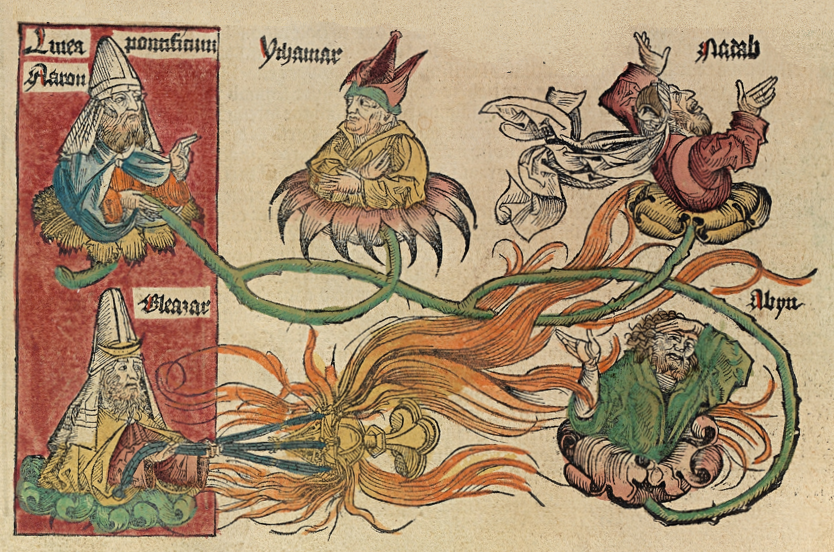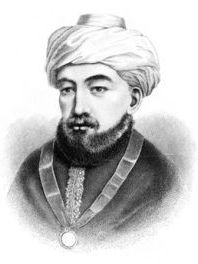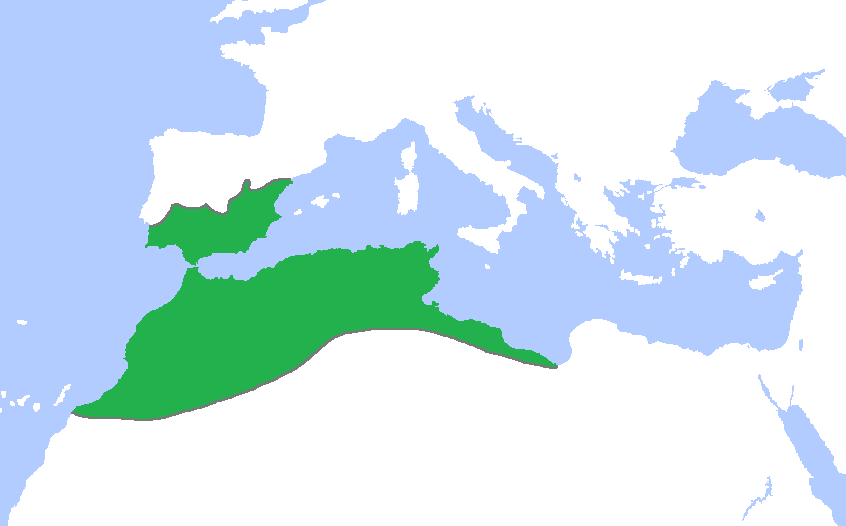|
Tzaraath
''Tzaraath'' (Hebrew: ''ṣāraʿaṯ''), variously transcribed into English and frequently translated as leprosy (though it is not Hansen's disease, the disease known as "leprosy" in modern times), is a term used in the Bible to describe various ritually impure disfigurative conditions of the human skin, clothing, and houses. Skin ''tzaraath'' generally involves patches that are white and contain unusually colored hair.D. L. Kaplan, "Biblical leprosy: an anachronism whose time has come", ''J Am Acad Dermatol'' 1993 Mar;28(3):507-10. doi: 10.1016/0190-9622(93)70071-z. Clothing and house ''tzaraath'' consists of a reddish or greenish discoloration. The laws of ''tzaraath'' are given in depth in chapters 13– 14 of Leviticus, and several Biblical stories describe individuals who have contracted ''tzaraath''. Name Variant transcriptions of the name into English include ''saraath'', ''zaraath'', ''tzaraat'', ''tsaraat'', ''tzaraas'', and ''tsaraas''. The Hebraic root ''tsara ... [...More Info...] [...Related Items...] OR: [Wikipedia] [Google] [Baidu] |
Hebrew Language
Hebrew (; ; ) is a Northwest Semitic language of the Afroasiatic language family. Historically, it is one of the spoken languages of the Israelites and their longest-surviving descendants, the Jews and Samaritans. It was largely preserved throughout history as the main liturgical language of Judaism (since the Second Temple period) and Samaritanism. Hebrew is the only Canaanite language still spoken today, and serves as the only truly successful example of a dead language that has been revived. It is also one of only two Northwest Semitic languages still in use, with the other being Aramaic. The earliest examples of written Paleo-Hebrew date back to the 10th century BCE. Nearly all of the Hebrew Bible is written in Biblical Hebrew, with much of its present form in the dialect that scholars believe flourished around the 6th century BCE, during the time of the Babylonian captivity. For this reason, Hebrew has been referred to by Jews as ''Lashon Hakodesh'' (, ) since a ... [...More Info...] [...Related Items...] OR: [Wikipedia] [Google] [Baidu] |
English Translations Of The Bible
Partial Bible translations into languages of the English people can be traced back to the late 7th century, including translations into Old and Middle English. More than 100 complete translations into English have been written. In the United States, 55% of survey respondents who read the Bible reported using the King James Version in 2014, followed by 19% for the New International Version, 18% for the three next most popular versions combined, and less than 10% for all other versions. Old English The Bible in its entirety was not translated into English until the Middle English period, with John Wycliffe's translation in 1382. In the centuries before this, however, many had translated large portions of the Bible into English. Parts of the Bible were first translated from the Latin Vulgate into Old English by a few monks and scholars. Such translations were generally in the form of prose or as interlinear glosses (literal translations above the Latin words). Very few complete ... [...More Info...] [...Related Items...] OR: [Wikipedia] [Google] [Baidu] |
Kohen
Kohen ( he, , ''kōhēn'', , "priest", pl. , ''kōhănīm'', , "priests") is the Hebrew word for "priest", used in reference to the Aaronic priesthood, also called Aaronites or Aaronides. Levitical priests or ''kohanim'' are traditionally believed and halakhically required to be of direct patrilineal descent from the biblical Aaron (also ''Aharon''), brother of Moses. During the existence of the Temple in Jerusalem, ''kohanim'' performed the daily and holiday ( Yom Tov) duties of sacrificial offerings. Today, ''kohanim'' retain a lesser though distinct status within Rabbinic and Karaite Judaism and are bound by additional restrictions according to Orthodox Judaism. In the Samaritan community, the kohanim have remained the primary religious leaders. Ethiopian Jewish religious leaders are sometimes called '' kahen'', a form of the same word, but the position is not hereditary and their duties are more like those of rabbis than kohanim in most Jewish communities. Etymolo ... [...More Info...] [...Related Items...] OR: [Wikipedia] [Google] [Baidu] |
Abraham Ben David
Abraham ben David ( – 27 November 1198), also known by the abbreviation RABaD (for ''Rabbeinu'' Abraham ben David) Ravad or RABaD III, was a Provençal rabbi, a great commentator on the Talmud, ''Sefer Halachot'' of Rabbi Yitzhak Alfasi and '' Mishne Torah'' of Maimonides, and is regarded as a father of Kabbalah and one of the key and important links in the chain of Jewish mystics. Biography RABaD's maternal grandfather, Rabbi Yitzhak b. Yaakov Ibn Baruch of Mérida (1035–1094), who had compiled astronomical tables for the son of Shemuel ha-Nagid, was one of five rabbis in Spain renowned for their learning. Concerning the oral history of his maternal grandfather's family and how they came to Spain, the RABaD wrote: "When Titus prevailed over Jerusalem, his officer who was appointed over Hispania appeased him, requesting that he send to him captives made-up of the nobles of Jerusalem, and so he sent a few of them to him, and there were amongst them those who made curtain ... [...More Info...] [...Related Items...] OR: [Wikipedia] [Google] [Baidu] |
Tosefta
The Tosefta ( Jewish Babylonian Aramaic: תוספתא "supplement, addition") is a compilation of the Jewish oral law from the late 2nd century, the period of the Mishnah. Overview In many ways, the Tosefta acts as a supplement to the Mishnah (''tosefta'' means "supplement, addition"). The Mishnah ( he, משנה) is the basic compilation of the Oral law of Judaism; according to the tradition, it was compiled in 189 CE. The Tosefta closely corresponds to the Mishnah, with the same divisions for ''sedarim'' ("orders") and ''masekhtot'' ("tractates"). It is mainly written in Mishnaic Hebrew, with some Aramaic. At times the text of the Tosefta agrees nearly verbatim with the Mishnah. At others there are significant differences. The Tosefta often attributes laws that are anonymous in the Mishnah to named Tannaim. It also augments the Mishnah with additional glosses and discussions. It offers additional aggadic and midrashic material, and it sometimes contradicts the Mishnah in ... [...More Info...] [...Related Items...] OR: [Wikipedia] [Google] [Baidu] |
Mishnah Torah
The ''Mishneh Torah'' ( he, מִשְׁנֵה תּוֹרָה, , repetition of the Torah), also known as ''Sefer Yad ha-Hazaka'' ( he, ספר יד החזקה, , book of the strong hand, label=none), is a code of Rabbinic Jewish religious law (''halakha'') authored by Maimonides (Rabbi Moshe ben Maimon/Rambam). The ''Mishneh Torah'' was compiled between 1170 and 1180 CE (4930 and 4940 AM), while Maimonides was living in Egypt, and is regarded as Maimonides' ''magnum opus''. Accordingly, later sources simply refer to the work as "''Maimon''", "''Maimonides''", or "''RaMBaM''", although Maimonides composed other works. ''Mishneh Torah'' consists of fourteen books, subdivided into sections, chapters, and paragraphs. It is the only Medieval-era work that details all of Jewish observance, including those laws that are only applicable when the Temple in Jerusalem is in existence, and remains an important work in Judaism. Its title is an appellation originally used for the Biblical bo ... [...More Info...] [...Related Items...] OR: [Wikipedia] [Google] [Baidu] |
Maimonides
Musa ibn Maimon (1138–1204), commonly known as Maimonides (); la, Moses Maimonides and also referred to by the acronym Rambam ( he, רמב״ם), was a Sephardic Jewish philosopher who became one of the most prolific and influential Torah scholars of the Middle Ages. In his time, he was also a preeminent astronomer and physician, serving as the personal physician of Saladin. Born in Córdoba, Almoravid Empire (present-day Spain), on Passover eve, 1138 (or 1135), he worked as a rabbi, physician and philosopher in Morocco and Egypt. He died in Egypt on 12 December 1204, when his body was taken to the lower Galilee and buried in Tiberias. During his lifetime, most Jews greeted Maimonides' writings on Jewish law and ethics with acclaim and gratitude, even as far away as Iraq and Yemen. Yet, while Maimonides rose to become the revered head of the Jewish community in Egypt, his writings also had vociferous critics, particularly in Spain. Nonetheless, he was posthumously ... [...More Info...] [...Related Items...] OR: [Wikipedia] [Google] [Baidu] |
Abscess
An abscess is a collection of pus that has built up within the tissue of the body. Signs and symptoms of abscesses include redness, pain, warmth, and swelling. The swelling may feel fluid-filled when pressed. The area of redness often extends beyond the swelling. Carbuncles and boils are types of abscess that often involve hair follicles, with carbuncles being larger. They are usually caused by a bacterial infection. Often many different types of bacteria are involved in a single infection. In many areas of the world, the most common bacteria present is '' methicillin-resistant Staphylococcus aureus''. Rarely, parasites can cause abscesses; this is more common in the developing world. Diagnosis of a skin abscess is usually made based on what it looks like and is confirmed by cutting it open. Ultrasound imaging may be useful in cases in which the diagnosis is not clear. In abscesses around the anus, computer tomography (CT) may be important to look for deeper infection. St ... [...More Info...] [...Related Items...] OR: [Wikipedia] [Google] [Baidu] |
Jacob Milgrom
Jacob Milgrom (February 1, 1923 – June 5, 2010) was a prominent American Jewish Bible scholar and Conservative rabbi. Milgrom's major contribution to biblical research was in the field of cult and worship. Although he accepted the documentary hypothesis, contrary to the classical bible critics, he traced a direct line of development from the Priestly Code (P), to the Holiness Code (H), to the cultic innovations of Ezekiel, to the cultic writings of the Dead Sea sect and finally to Jewish law (halacha) of the Mishnah and Talmud. Best known for his comprehensive Torah commentaries and work on the Dead Sea Scrolls, he also published extensively on the Book of Ezekiel. Biography Jacob Milgrom was born in Brooklyn, New York in 1923. He studied at Brooklyn College and the Jewish Theological Seminary of America in New York City. In 1948, he married Jo Berman, also a biblical scholar. They had four children. Academic career Jacob Milgrom spent most of his career at the University of ... [...More Info...] [...Related Items...] OR: [Wikipedia] [Google] [Baidu] |
Wasp
A wasp is any insect of the narrow-waisted suborder Apocrita of the order Hymenoptera which is neither a bee nor an ant; this excludes the broad-waisted sawflies (Symphyta), which look somewhat like wasps, but are in a separate suborder. The wasps do not constitute a clade, a complete natural group with a single ancestor, as bees and ants are deeply nested within the wasps, having evolved from wasp ancestors. Wasps that are members of the clade Aculeata can Stinger, sting their prey. The most commonly known wasps, such as yellowjackets and hornets, are in the family Vespidae and are Eusociality, eusocial, living together in a nest with an egg-laying queen and non-reproducing workers. Eusociality is favoured by the unusual haplodiploid system of sex-determination system, sex determination in Hymenoptera, as it makes sisters exceptionally closely related to each other. However, the majority of wasp species are solitary, with each adult female living and breeding independently ... [...More Info...] [...Related Items...] OR: [Wikipedia] [Google] [Baidu] |
Encyclopedia Biblica
''Encyclopaedia Biblica: A Critical Dictionary of the Literary, Political and Religion History, the Archeology, Geography and Natural History of the Bible'' (1899), edited by Thomas Kelly Cheyne and J. Sutherland Black, is a critical encyclopedia of the Bible. In theology and biblical studies, it is often referenced as ''Enc. Bib.'', or as ''Cheyne and Black''. Description It has an article for every single name and place both in the Bible and in its traditional Apocrypha, as well as for each of the books of these, together with many improper nouns appearing in these (such as ''nebi'im'', 'mole', 'owl') and other more general subjects (such as 'music', 'tents', etc.). Many of these articles are given in great detail, and usually include mention of the various spellings for each word as used by the Masoretic Text, Septuagint (differentiating between each of the most important ancient manuscripts), and by other ancient versions; the largest article is that on the Gospels, which i ... [...More Info...] [...Related Items...] OR: [Wikipedia] [Google] [Baidu] |
Root Word
A root (or root word) is the core of a word that is irreducible into more meaningful elements. In morphology, a root is a morphologically simple unit which can be left bare or to which a prefix or a suffix can attach. The root word is the primary lexical unit of a word, and of a word family (this root is then called the base word), which carries aspects of semantic content and cannot be reduced into smaller constituents. Content words in nearly all languages contain, and may consist only of, root morphemes. However, sometimes the term "root" is also used to describe the word without its inflectional endings, but with its lexical endings in place. For example, ''chatters'' has the inflectional root or lemma ''chatter'', but the lexical root ''chat''. Inflectional roots are often called stems, and a root in the stricter sense, a root morpheme, may be thought of as a monomorphemic stem. The traditional definition allows roots to be either free morphemes or bound morphemes. Roo ... [...More Info...] [...Related Items...] OR: [Wikipedia] [Google] [Baidu] |


.jpg)




